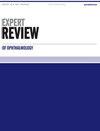Mechanisms for the symptoms of dryness in soft contact lens wearers
IF 0.9
Q4 OPHTHALMOLOGY
引用次数: 0
Abstract
ABSTRACTIntroduction Dryness symptoms in soft contact lens (SCL) wearers are common, especially at the end of the day, and are the most common reason for discontinuing wear.Areas covered With references to mechanisms for dry eye syndromes in non-SCL wearers, this review examines mechanisms whereby dryness symptoms are generated during SCL wear, including the significance of endogenous tear dysfunctions, pre-lens tear film instability, post-lens tear film volumes and stagnation, tear hyperosmolarity, blink inefficiency, SCL material dehydration, and front surface biocompatibility and wetness.Expert opinion Numerous efforts have been made to reduce dryness symptoms by improving SCL materials and surfaces, but the prevalence of dryness symptoms remains stubbornly high. It is possible that symptoms might be due to neuropathy and associated increases in corneal and/or lid wiper sensitivity that develops during SCL wear. For example, over time sensory thresholds for SCL awareness may be lowered and/or conditions that increase their perception sharpened. There are several mechanisms for contributions to thinner pre-lens tear films and reduced SCL biocompatibility. Dryness symptoms may occur with bandage SCL, perhaps especially in a previous wearer of SCL.KEYWORDS: Dry eyecontact lensOcular surfaceCorneaTearssymptomsDisclaimerAs a service to authors and researchers we are providing this version of an accepted manuscript (AM). Copyediting, typesetting, and review of the resulting proofs will be undertaken on this manuscript before final publication of the Version of Record (VoR). During production and pre-press, errors may be discovered which could affect the content, and all legal disclaimers that apply to the journal relate to these versions also. Declaration of interestsThe author has no relevant affiliations or financial involvement with any organization or entity with a financial interest in or financial conflict with the subject matter or materials discussed in the manuscript. This includes employment, consultancies, honoraria, stock ownership or options, expert testimony, grants or patents received or pending, or royalties.Reviewer disclosuresPeer reviewers on this manuscript have no relevant financial or other relationships to disclose.Article highlightsEvidence does not support the expectation that the division of the pre-corneal tear film into two layers by a SCL is a contributor to subsequent quantitative or qualitative aqueous, lipid or mucus deficiency and the risk of lens dehydration.Any SCL-related reduction in aqueous production, combined with increased rates of aqueous loss by evaporation (shorter TBUT), could explain lower tear meniscus heights during SCL wear.Insulation of the cornea from normal atmospheric blink stimuli by a SCL may contribute to aqueous production deficiency and/or blink inefficiency, with associated increased lens drying. For example, corneal insulation from blink stimuli such as exposure to air movement, dust and pollution could reduce blink rates during the most comfortable period of lens wear during the start of the day. Reduced blink rates and longer interblink periods increase the risk of lens surface drying and surface deposits. Subsequently, lid wiper stimulation in response to progressive lens front surface degradation might explain increased blink rates as comfort deteriorates toward the end of the day. Insulation of the cornea by a SCL may also contribute to blink inefficiency in the form of higher rates or degrees of incomplete blinking. In addition, any degree of lagophthalmos will increase the influence of incomplete blinking on blink inefficiency.Lack of tear exchange and related stagnancy of the post-lens tear film (PoLTF), especially to the degree that it becomes hyperosmotic and its toxicity becomes increasingly concentrated by lens material dehydration and associated PoLTF thinning, may help explain adverse changes to the corneal glycocalyx and epithelial cells that can be induced by SCL wear.Corneal epithelial degradation with SCL wear may be detrimental to its neurotrophic functions and help explain corneal neuropathy (and symptoms of dryness?).However, SCL dryness symptoms may be more of a function of lid wiper stimulation by dry areas on the lens front surface.Despite numerous attempts to improve SCL surfaces to improve their wettability and lubricity, as well as resistance to deposition by tear components such as proteins, lipids and bacteria, dryness symptoms continue to be a major problem.Chronic sub-clinical inflammatory responses to SCL wear might be an intrinsic risk to the extent that sustained inflammation can damage tissue and associated necrosis can increase inflammatory responses.It is not known to what extent symptoms of dryness with SCL wear are due to adverse lens changes or are due to increases in sensitivity to them due to lowering thresholds for lens awareness.Because dryness symptoms are the most common reason for discontinuing SCL wear, a better understanding of mechanisms for stimulating dryness symptoms, especially end-of-day dryness symptoms, is needed.Knowing the degree to which stimulation of the cornea and/or lid wiper contributes to dryness symptoms might help develop amelioration responses to them.Additional informationFundingThis paper was not funded.软性隐形眼镜佩戴者干燥症状的机制
由于干燥症状是停止使用SCL的最常见原因,因此需要更好地了解刺激干燥症状的机制,特别是一天结束时的干燥症状。了解刺激角膜和/或雨刷对干燥症状的影响程度,可能有助于改善对这些症状的反应。本文未获得资助。
本文章由计算机程序翻译,如有差异,请以英文原文为准。
求助全文
约1分钟内获得全文
求助全文
来源期刊

Expert Review of Ophthalmology
Health Professions-Optometry
CiteScore
1.40
自引率
0.00%
发文量
39
期刊介绍:
The worldwide problem of visual impairment is set to increase, as we are seeing increased longevity in developed countries. This will produce a crisis in vision care unless concerted action is taken. The substantial value that ophthalmic interventions confer to patients with eye diseases has led to intense research efforts in this area in recent years, with corresponding improvements in treatment, ophthalmic instrumentation and surgical techniques. As a result, the future for ophthalmology holds great promise as further exciting and innovative developments unfold.
 求助内容:
求助内容: 应助结果提醒方式:
应助结果提醒方式:


